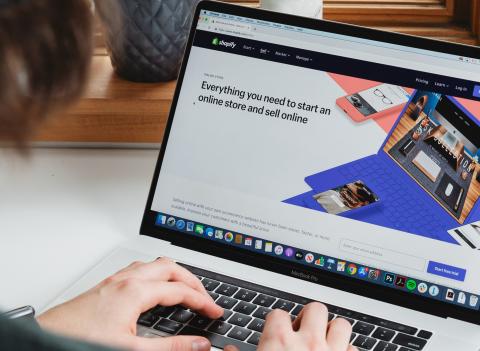Everything you ever wanted to know about digital: a Superfast Business Wales Q&A
Throughout the pandemic digital has been a lifeline for small business owners, helping them stay in touch with customers, sell online and keep their business going while they’ve been limited by COVID-19 restrictions.
For Caerphilly-based tutoring business Educalis, this is especially true. When lockdown prevented the firm from delivering face-to-face lessons, it sought help from Superfast Business Wales to quickly switch to online learning. It was a move that owner Emma Blewden says “saved the business.” Read the full story.
If you want to survive COVID-19 using digital, scroll below to read the answers to our most frequently asked questions and join business owners, like Emma, so we can help you build your digital confidence.
Below, Superfast Business Wales trainer Austin Walters answers the questions you asked us about digital. Click a question to see the answer.
- How do I market my business online?
- How do I sell online?
- How do I run my business online?
- How do I use digital to save time and be more efficient?
How do I market my business online?
This entirely depends on your business. Different business types need to look at strategies for their sector rather than having a “one size fit all” approach.
What might be a great strategy for a local shop might be terrible for a financial adviser. One of the mistakes many business owners make online is to copy the strategy another business is using successfully, regardless of what sector they’re in. This is not guaranteed to work and may even cause harm.
Another common mistake people make is to market on the platform they are most comfortable using, which is not necessarily the one best suited to reach their target market.
So first, you need to identify your target market. This is something I cover in more detail on our Superfast Business Wales Digital Marketing workshops.
When you know who you are targeting, you can develop a campaign to reach them with the right messaging.
There are multiple channels to market online, but for this article I will keep it simple. Let’s consider Search (as in Google Search) -v- Social Media.
When someone performs a search, they are much closer to the buying decision than someone who stumbles across your post or advert on social media. Therefore we need to have different approaches. We cannot treat every person as a prospect.
Imagine you wake up and decide to buy a washing machine. You want to see the product before you buy so you go to a local electrical store. When you arrive you want someone to sell to you: that’s why you went there, for help to choose the best machine for your needs. You identify one with the help of a salesperson, spend your money, and leave with a delivery booked. This is like shopping online via search.
Now imagine you didn’t wake up wanting to buy a washing machine but instead decide to go to the park with your family. Whilst you’re there some random person comes up to you and tries to sell you a washing machine; well, that’s like social media: you got interrupted while you were looking at cat videos.
The above is a good example of needing to know how your target market (potential customers) start their journey to find your product or service. Note, not all prospects who start with search are ready to buy; they may be in information gathering mode.
How do I sell online?
Today there are multiple solutions to selling online. You could create an e-commerce store with WordPress and WooCommerce, or you could use a ready built “online shop” such as Shopify. There are pros and cons to both. Shopify is ready built, hosted for you, and comes with many features already built in. All you need to do is set up your company details, input the products, confirm shipping and postage costs, and go live. Read our Shopify guide for more.
With WordPress and WooCommerce, you start from scratch and build the site first, then you enter all your products, etc.
We can’t overlook platforms such as Amazon, eBay, Etsy and other emerging marketplaces either. The perceived downside of selling your products through these platforms is you pay a commission on each sale. However, they come with a huge upside and that’s a ready-made hungry crowd of buyers.
If you sell services rather than products, you may want a non-commerce website or perhaps a funnel sales approach. Also consider marketplaces such as fiverr and People Per Hour.
How do I run my business online?
There are a number of online tools available which can help you switch from a paper-based office to a digital one. In fact, as cloud hosted software becomes more and more affordable and easy to use, most of the tools I use now to run my business are online.
For instance, my accounts program is Xero - a cloud hosted accounting and invoicing program that allows me, my accountant, and bookkeeper to access my accounts at anytime from anywhere. It gives you instant access to your accounts in real-time and is a much easier way for you to stay in control and keep on top of the books.
I also use Microsoft 365 for my office suite, which includes a 50GB email inbox, a 1TB online cloud storage along with Word, Excel, ToDo, Online Forms, Planner and much more – again I can log into all of these remotely.
For those who prefer to use Google, G-Suite has been relaunched as Google Workspace which includes email, online storage and a really great video conferencing tool called Google Meet. All of these tools can be accessed from anywhere and make it easy for you to run your business online. Again I cover many of these and more on the free online business tools webinar.
How can I use digital to save time and be more efficient?
No business owner wants to be bogged down with paperwork when they could be running the business. This is where digital really comes into its own. Digital tools can help to lessen the load by doing the work for you, so you spend less time on admin and more time focusing on what’s important.
Microsoft Power Automate is a great tool that helps with repetitive tasks. Xero allows you to set up automatic online invoicing and invoice payment chasing for late payers.
Evernote is another useful tool which works like an online filing cabinet. You can scan documents such as job quotes and Evernote converts it to a pdf and saves it in your online filing system in a named section of your choice – e.g., November work quotes. It not only cuts down on paperwork, but it also reduces the danger of losing files as everything is stored safely online. Using these can save you hours in a week. In fact, it’s just like having an extra pair of hands.
Combine that with a decent Customer Relationship Management (CRM) system to make you more organised with customers and you’re really starting to become a more efficient business owner. Read how Walker Chiropractic uses a CRM to save time and deliver a better service to patients.
Austin Walters delivers a range of digital tech webinars for Superfast Business Wales.





